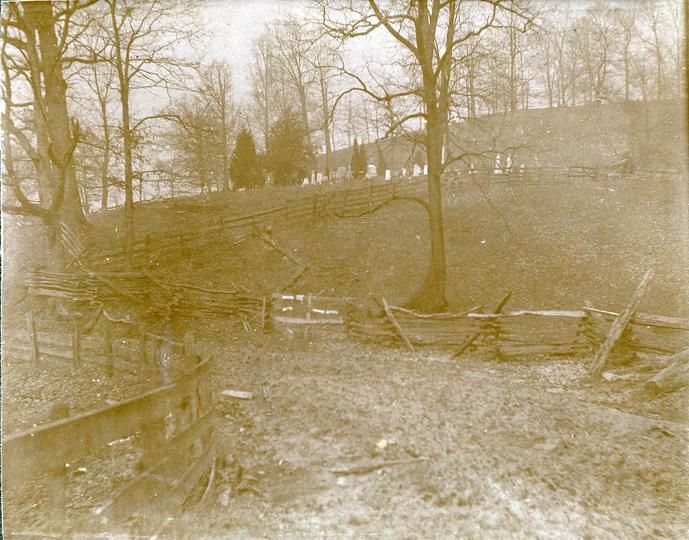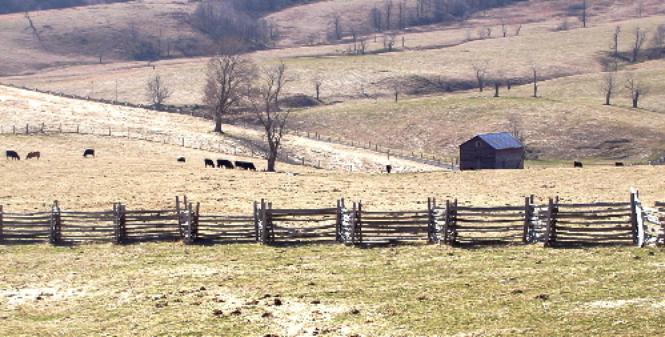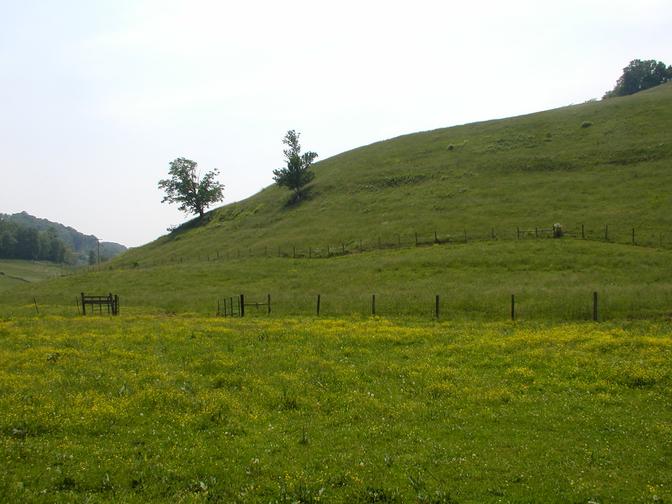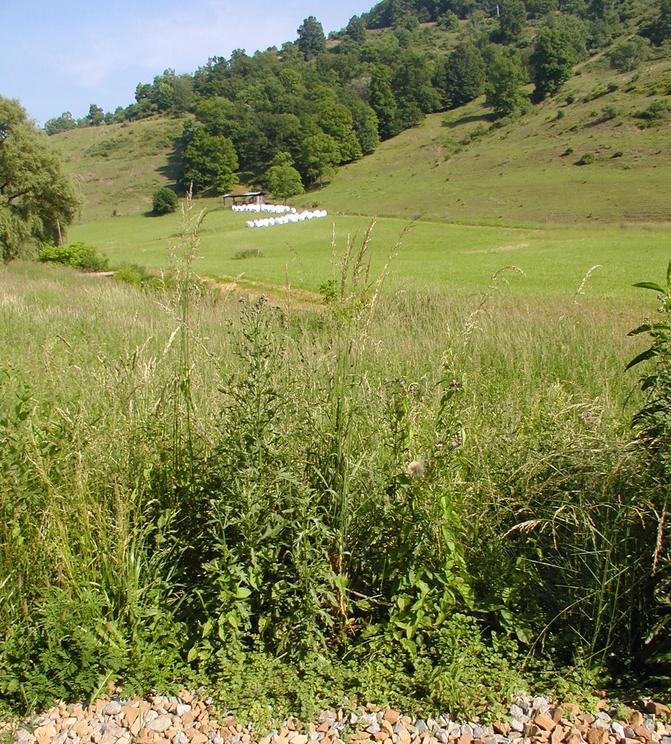
| Next Chapter | Previous Chapter | |
| Chapter 8: Earliest Memories:4. At First I Hated Farming | Contents | Chapter 6: The Apple Business |
When my grandfather bought the farm at Lost Creek from the Van Horn family, the hillsides were covered with "moonshine and ripshin briers, not even good broomsage." Moonshine was the name for a little plant with broad leaves that stood up rather straight which had dark green velvet on the upper side and a very light green velvet on the lower. The leaves were about two to three inches tall and perhaps half to three-fourths of an inch wide. Moonshine got its name from the way the hillside looked when the wind blew and rippled the leaves. The ripshin briers disappeared from our pasture by 1940 or so, but were still present in the adjacent land Grandfather sold Uncle O. B. Bond, and were there until perhaps 1980 or so.
The reason for this plant cover was that the predecessors had planted corn in rows that ran straight up and down the hill, cultivated it regularly, and of course, used nothing to replace fertility that the corn took out. The bottom was a swamp. Hay was grown on the more elevated ground Granddad sold to O. B. Bond. Some people thought he was crazy to sell all the meadow to O. B., but he began to drain the swamp and got his hay from land that was not worn out, but was somewhat wet. This land also served to provide some corn. The hillside went into pasture.
There were great washes down the hill from where oil wells had been drilled. In those days saltwater from deep strata, found along with oil, was pumped out of the well and allowed to run down the hillside, killing grass and developing gullies. I can still show you marks on the ground where some of these are. They were mostly filled in a long time ago, and the grass production is constant across them now.
Some moonshine weed was still on the hillsides until I was grown, but it has gradually disappeared and broomsage is the dominant grass, and that is being displaced by better grasses slowly. I have used almost no lime on the pasture at Lost Creek. All that has been done is to "cut the filth," and avoid over pasturing the land.
There was a small entry into the old "house mine" on the little knob that has been removed by strip mining. I remember being pulled up there on a wagon by a team of horses, along with Dad, who drove, and Mother and possibly the sisters before the stripping took place. My father gave me the most dire warning against crawling into that mine or any other. Good advice because the mine roof was held up by wooden posts that were marginal when first in use, and long rotted in the damp mine atmosphere. The mine had been abandoned because natural gas became plentiful and cheap before my birth. Almost everyone used gas to heat and cook. The gas industry had been long established, and the hatred for Hope Gas in the area was well developed in my childhood.
Dad ran a dairy (more about that below), and in those days there were bare tracks down the hill to the left behind the barn where the cows came in each night. They threatened to become gullies, but those are gone now too, covered with grass.
At Jesse Run I have used the low-grade lime available from Allen Construction at Elkins, and used it liberally. It was in better shape than the Lost Creek farm from the beginning, because Carroll and Ressie Bond, my predecessors had used lime. Unfortunately, little of it went on the steep ground, because it was concentrated by their hired men on the more level parts of the pasture. Mr. George Dawson, of Lost Creek, has a long time familiarity with farming on Jesse Run. He and his son Wesley farmed on the Guy and Audra Lewis farm, and now own some of that land on the upper end of the run. He paid me a high complement concerning the changes I have made. He said the farm (in Dr. Howell's time, before Carroll and Ressie, our immediate predecessors) was known as the hardest farm on Jesse Run to keep "clean," (free of brush). Now it is the easiest.
(Illustration 7-1)

This photograph shows two kinds of fence, the "wormy rail fence" on the right, so named because the panel's rails meet at an approximately 90 degrees, and a board fence on the left. This picture was taken in front of the spot where George Dawson's house is now located. In the background is the "Old Frame Church Cemetary" used by the Seventh Day Baptist Church before 1898. Today it is within 150 yards of I-79. Notice the muddy condition of the road. Picture taken by Rev. M. G. Stillman. Photo courtesy of the S. D. B Historical Society
I believe the land will slowly improve itself for grazing if you prevent brush and trees from growing up, and do not overgraze. Lime is a great help, and fertilizer, too, but fertilizer is not necessary, if you have the time to wait for improvement.
The loss of apples wasn't the only environmental disaster in the memory of my elders. Not many years before, the Chestnut Blight had changed the composition of the Appalachian forest, in our neighborhood. An estimated 3.5 billion American chestnut trees were wiped out by a fungus, Cryphonectria (Endothia) parasitica, which accidentally was carried to this country in a shipment of exotic chestnut trees to the Bronx Zoo in 1904. These large, highly valued trees once dominated the Eastern forest of the United States. A recent article in the American Scientist announces the discovery that they were capable of preventing the germination of seeds of other species, reducing competition, which helped them gain prominence in the forest.
Roasted chestnuts were a remote memory at the time of my youth, and fattening hogs on the chestnuts fallen in the woods had been a common practice before the time of my grandfathers. However, there were lots of chestnut rails left when I was in my teens. Papaw Kennedy had a rail fence along the ridgeline behind their house, and used many under hay stacks to keep them up off the ground. I don't recall any mention of chestnut lumber, but the chestnut trees were straight and tall, and a major component of the forest.
Chestnut was both strong and easy to split, and was the wood of choice for rail fences, use under stacks, etc. The chestnuts were a major source of food for wildlife, too. The last piece of chestnut rail rotted away on the Jesse's Run farm in 1992. It had been part of a fence along the ridge back of the house.
In the midst of what the folks in my youth called The Great Depression (the one that started in 1929) there was a year with a terrible drought, 1931, I believe. What grass the drought did not get, the Army Worms did. Clifford Jackson told me that people went into the woods that winter and cut small branches for their cattle to eat, in place of hay, like they had in pioneer days, to keep them from starving. I don't know how my family dealt with it or got through it, but I remember Dad talking about the Army Worms.
(Illustration 7-2)

A rail fence near Monterey, Virginia. This is the closest one I know of now. Notice this fence has stakes set the corners of the "worm" turns, rather than a pair of extra rails laid over them.
Heconsidered the access to the creek across the road from Aunt Lotta's house an important asset of the Lost Creek farm, because it was a source of water for stock in drought.
I now use Crossbow, generously supplied by Dow Chemical at $50 a gallon (2003), on the rose and Autumn Olive, and other woody plants. It is quite effective, used according to directions. One gallon makes 100 gallons of spray, which takes about four hours to apply with a spray gun. My arthritic legs hurt to think about it, even, so much walking. The main thing is to avoid inhaling it, I believe, although that possibility is hardly mentioned in the government required training. All they talk about is spilling it on yourself. I remember my experience in Industrial Hygiene some years ago, and there are only two cells between air and blood in the lungs, whereas your skin is a thick and effective barrier to most chemicals. Fat soluble compounds can migrate through your skin, but not as readily as across the blood-air barrier in your lungs. I don't have much faith in the government required training. The Agricultural people, even at the top, don't practice spraying and don't have appropriate background education for industrial hygiene matters. They have to handle the information presented to them by the corporations the way a high school teacher presents material to a class - without experience and without contact with people who have experience - just by rote and repetition.
Once, years ago, I got hit pretty bad with spray. I was working on the Ray Smith property when Ward Maxson owned it. I got in too much of a hurry, inhaled a bit of it, and was
(Illustration 7-3)

Very steep land nicely kept "clean" in the old fashioned way - Rt.33 West of Weston.
knocked out for three weeks. Fortunately it was raining most of the time, and I could loaf without being too conspicuous. Never told a soul. Till now.
I recently looked up the ingredients in Crossbow, and one ingredient is the same as the original spray, 2,4-D, and the other ingredient is an analog of 2,4,5-T which has only one atom different. The synthesis follows a different route and no dioxin is produced as a byproduct. Dioxin, which contaminated 2,4,5-T, is sometimes called "the most poisonous substance known to man." I have read that the mixture of 2,4-D and 2,4,5-T used in Viet Nam, called Agent Orange, had ten times the level of dioxin as the material sold to farmers in the United States. It is widely believed to be the cause of the "Agent Orange Syndrome" experienced by many soldiers who served there, including our neighbor Tom Akers, who is fighting cancer, one of the principal complaints.
A happy change is the return of deer to the area. They were hunted to extinction with dogs in the 1880's. I have heard older men say that the day you saw so much as a deer foot print at a spring it made your day in the 1910s and 1920s. In the 20's Jackson's Mill State 4-H Camp was started, and they kept a few deer in pens for people to see, like a zoo. Some of them escaped, and some worked their way back in to this country from the mountains to the East, where they never became extinct. At one time I allowed more than one hundred people to hunt this 515 acre farm each year, and it didn't affect the number of deer the next year.
Now I lease hunting rights to a maximum of 24 hunters. It is all carefully regulated, and I have insurance to cover any accident. Turkey have been released by the DNR, and we have a population on this farm of a hundred or more, there are so many they compete with the deer for mast (fallen nuts) in the fall.
(Illustration 7-4)

A Devil-Weed, Cirsium arcense, commonly known as Canadian Thistle, three plants right at the edge of the gravel along a road. Purple flowers on the left plant and dirty grey seeds about ready to fly on the right. Plastic wrapped bales in the background. Also pasture "going back to the Indians."
The current invasions worth mentioning are three kinds of thistles I discovered several years ago on the Jesse Run farm. I couldn't find them in books on the local flora, so when Esther and I went to see our daughter Charlita in the Grand Tetons, I picked up a book on the flora of the High Plains and found all three of them, I thought. Next summer (1996) I called in someone from the State Plant Pathologist's office and he gave me two of the names I had picked out.
The one that worried me the worst was Cirsium arcense, which grows in the meadow both here at Jesse's Run and at Lost Creek. It does well where it gets plenty of water and follows drains and blind ditches (rock drains used before tile). I worried for several years that the cattle would reject hay contaminated with it, but have found out they will eat it as hay and as pasture if it is young, so don't worry so much about it. Cardus nutans is the most conspicuous, growing on the strip job, where the pH is relatively high. It is very much attuned to the longest days of the year. (Note added: they soon became adapted to longer seasons.) The third is Cirsium discolor. This last grows in the pasture and the man from the Plant Pathologist's Office looked for and found caterpillars which had been released to eat the bud and prevent spreading. It is most like our native thistle, Cirsium vulgare.
I have observed C. arcense along the road all the way to Chicago, and in many places in Central West Virginia, including Eastpointe, across from the Texas Roadhouse Resturant. It will soon be everywhere. C. nutans is not eaten by the stock, and is a serious nuisance, very well adapted to our higher pH soils, which are deep soils stirred up by strip mining. I think all three thistles have come here from the West along the interstate, which is essentially an open road for some plants. The trucks carry and blow seeds.
Another environmental change I want to mention is the incursion of the Varoa Mite of honey bees. When I was a kid white clover was very common in pasture in lawns, everywhere. The bees pollinated white clover. We had to watch for them on white clover when we went barefoot. The clover was mixed with Kentucky Bluegrass in most pasture, because these two were the species of grass that were most resistant to over grazing and grew in lawns which were mowed close with mowers. Most people did not divide their pastures for rotation, because that required more fence to build and maintain and the advantages weren't known.
Now the bees are about gone, except for carefully managed hives. They say they will adapt and will come back. (The following added in 2002, two years after this was first written.) I have read recently that there is a trachea mite and a third insect that is part of the problem. Experts are not so optimistic about the future of bees now. The present situation is a severe handicap for those who produce crops pollinated by bees, such as apples and melons. Professional beekeepers must work very hard to preserve their hives with various medications. (Added in 2007) Still another disease of bees has been announced. Bee keepers carefully managed hives may decrease by half in one winter at this point.
The last environmental change in recent years I want to mention is the incursion of coyotes. They are a new species in this area. We used to think coyotes were strictly a western species, but they are here now. One story is that they came in from the north because of the increased cover on what was once cleared farm land in the East. The other story is that the Department of Natural Resources brought them in to control the turkeys, which is vigorously denied.
I don't trust the DNR. They run a land-intensive business without owning land and are responsible to the legislature only. They employ too few to effectively police hunting. There is huge money involved in the meals, gasoline, guns, overnight accommodation, clothing, camping trailers and other accoutrements hunters buy. Doubtless, hundreds of millions of dollars, but you never see the figure. Great for the economy, they say. Lots of pressure for hunting, and no return to the land owner unless you are very acute in getting it, nor is there any contribution made to maintaining the land.
Coyotes eat turkeys and fawns. They crack calves bones for the marrow, which makes it very easy to identify the culprit. Dick Rogers, one of my hunters, was up near the top of the hill one day scouting turkey, when the fire siren opened up at Lost Creek. He said coyotes howled with it all around him. It made his scalp crawl. Although he is an excellent observer, he didn't know they were there. I never see them, on the tractor or on foot, because they are too sly.
The coyotes have driven out the foxes - eliminated them, better said. As a consequence there is an abundance of rabbits around our house, something we have not seen for many years. The dogs are too well fed and lazy to bother a rabbit, even a small one. The coyote's favorite meal, though, is house cats. Quite a few small dogs have been taken by them, too.
Aside The Chestnut Blight changed the eastern forest by removing one of its major components, but a greater change is coming. We have been hearing about a disease called Sudden Oak Death in California for several years now. Knowledgeable people are holding their breath because the list of known hosts is over one hundred. Oaks and Hickory are the two major components of the Eastern forest now, and both are effected. The disease is also known to effect Rhododendron, the West Virginia state flower, and Azaleas.
The causative agent, Phytophthora ramorium, was discovered in Germany and Holland in 1993 and in California in2000. The East has been exposed by nursery stock shipped in 2003. The State Department of Agriculture has set up a polymerase chain reaction lab to confirm the DNA of suspected disease samples. It seems likely to this author that it is a matter of time until the Eastern forest undergoes a further degradation as the result of a foreign disease organism.
| Next Chapter | Previous Chapter | |
| Chapter 8: Earliest Memories:4. At First I Hated Farming | Contents | Chapter 6: The Apple Business |
Copyright © 1998, 2006, 2008, 2011 S. Tom Bond (stombond at hughes.net)